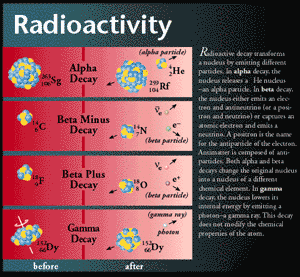Radioactivity


Atoms are radioactive if the protons and neutrons in the nucleus are configured in an unstable way. For low numbers of protons (Z), the number of neutrons (N) required to maintain a stable balance is roughly equal to the number of protons. For example, there are 6 protons and 6 neutrons in the nucleus of the most abundant form of carbon. For large numbers of protons in the nucleus, the repulsive electric force between protons leads to stable nuclei that favor neutrons over protons. One stable nucleus of lead contains 126 neutrons and 82 protons. A radioactive atom, lacking a proper balance between the number of protons and the number of neutrons, seeks a more stable arrangement through radioactive decay. These decays occur randomly in time, but large collections of radioactive materials have predictable mean lifetimes. The common decay products are named after the first three letters of the Greek alphabet—alpha (a), beta (b), and gamma (g). In an alpha decay, a helium nucleus escapes from a nucleus. Alpha emission reduces the number of protons by two and also the number of neutrons in the nucleus by two. Beta decay can proceed either by emission of an electron, and an antineutrino or by emission of their antiparticles, a positron and a neutrino. Beta decay changes the number of protons and the number of neutrons in the nucleus by converting one into the other. Inverse beta decay involves the capture of an electron by a nucleus. In a gamma decay a high energy photon leaves the nucleus and allows the nucleus to achieve a more stable, lower energy configuration. Spontaneous fission of a large-mass nucleus into smaller-mass products is also a form of radioactivity.
|

